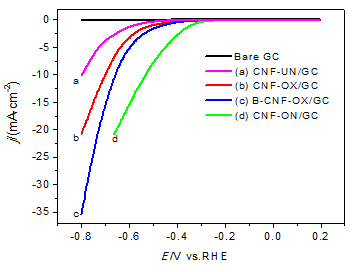| [1] Liu, L.; Zha, D.-W.; Wang, Y.; He, J.-B. Int. J. Hydrogen Energy 2014, 39, 14712.
[2] Cao, X.; Han, Y.; Gao, C.; Xu, Y.; Huang, X.; Willander, M.; Wang, N. Nano Energy 2014, 9, 301.
[3] Bessel, C. A.; Laubernds, K.; Rodriguez, N. M.; Baker, R. T. K. J. Phys. Chem. B 2001, 105, 1115.
[4] Aricò, A. S.; Bruce, P.; Scrosati, B.; Tarascon, J.-M.; Van Schalkwijk, W. Nat. Mater. 2005, 4, 366.
[5] Taylor, R.; Humffray, A. J. Electroanal. Chem. Interfacial Electrochem. 1975, 64, 63.
[6] Zhong, R.-S.; Qin, Y.-H.; Niu, D.-F.; Zhang, X.-S.; Zhou, X.-G.; Sun, S.-G.; Yuan, W.-K. Electrochim. Acta 2013, 89, 157.
[7] Qin, Y.-H.; Jiang, Y.; Niu, D.-F.; Zhang, X.-S.; Zhou, X.-G.; Niu, L.; Yuan, W.-K. J. Power Sources 2012, 215, 130.
[8] Qin, Y.-H.; Li, H.-C.; Yang, H.-H.; Zhang, X.-S.; Zhou, X.-G.; Niu, L.; Yuan, W.-K. J. Power Sources 2011, 196, 159.
[9] Zhang, Z.-G.; Zhao, T.-K.; Li, T.-H.; Wang, J.-B.; Guo, Z.-X. Carbon 2014, 26. (张智广, 赵廷凯, 李铁虎, 王建兵, 郭争光, 炭素, 2014, 26.)
[10] Cao, Y.; Yu, H.; Tan, J.; Peng, F.; Wang, H.; Li, J.; Zheng, W.; Wong, N.-B. Carbon 2013, 57, 433.
[11] Zhao, D.-M.; Li, Z.-W.; Liu, L.-D.; Zhang, Y.-H.; Ren, D.-C.; Li, J. Acta Chim. Sinica 2013, 72, 185. (赵冬梅, 李振伟, 刘领弟, 张艳红, 任德财, 李坚, 化学学报, 2013, 72, 185.)
[12] Lu, Z.-J.; Xu, M.-W.; Bao, S.-J.; Chai, H. Acta Chim. Sinica 2013, 71, 957. (鲁振江, 徐茂文, 包淑娟, 柴卉, 化学学报, 2013, 71, 957.)
[13] Qu, L.; Liu, Y.; Baek, J.-B.; Dai, L. ACS nano 2010, 4, 1321.
[14] Li, Y.; Mi, R.; Li, S.; Liu, X.; Ren, W.; Liu, H.; Mei, J.; Lau, W.-M. Int. J. Hydrogen Energy 2014, 39, 16073.
[15] Cheng, Y.; Tian, Y.; Fan, X.; Liu, J.; Yan, C. Electrochim. Acta 2014, 143, 291.
[16] Li, L.-X.; Zhao, H.-W.; Xu, W.-W.; Zhang, Y.-Q.; An, B.-G.; Geng, X. Acta Phys.-Chim. Sin. 2015, 31(3), 498. (李莉香, 赵宏伟, 许微微, 张砚秋, 安百钢, 耿新, 物理化学学报, 2015, 31(3), 498.)
[17] Zhang, J.; Wu, S.; Chen, X.; Pan, M.; Mu, S. J. Power Sources 2014, 271, 522.
[18] Ratso, S.; Kruusenberg, I.; Vikkisk, M.; Joost, U.; Shulga, E.; Kink, I.; Kallio, T.; Tammeveski, K. Carbon 2014, 73, 361.
[19] Zhong, R.-S.; Qin, Y.-H.; Niu, D.-F.; Tian, J.-W.; Zhang, X.-S.; Zhou, X.-G.; Sun, S.-G.; Yuan, W.-K. J. Power Sources 2013, 225, 192.
[20] Moncoffre, N.; Hollinger, G.; Jaffrezic, H.; Marest, G.; Tousset, J. Nucl. Instrum. Methods Phys. Res., Sect. B 1985, 7, 177.
[21] Figueiredo, J. L.; Pereira, M. F. R. Catal. Today 2010, 150, 2.
[22] Xie, J.; Zhang, J.; Li, S.; Grote, F.; Zhang, X.; Zhang, H.; Wang, R.; Lei, Y.; Pan, B.; Xie, Y. J. Am. Chem. Soc. 2013, 135, 17881.
[23] Liu, B.; He, J.-B.; Chen, Y.-J.; Wang, Y.; Deng, N. Int. J. Hydrogen Energy 2013, 38, 3130.
[24] Jiang, Y.; Zhang, J.; Qin, Y.-H.; Niu, D.-F.; Zhang, X.-S.; Niu, L.; Zhou, X.-G.; Lu, T.-H.; Yuan, W.-K. J. Power Sources 2011, 196, 9356. |
